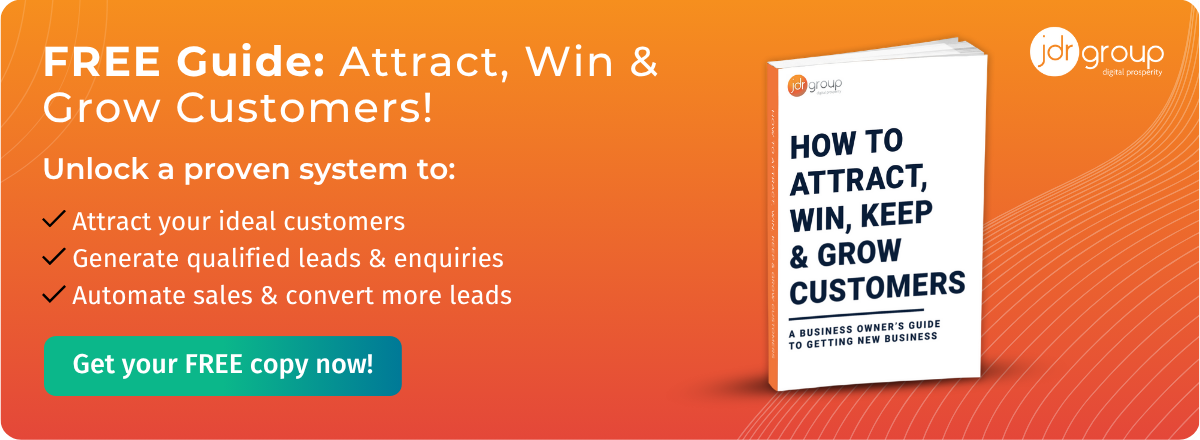The Role Of Marketing In Your Business Growth Strategy
.png?width=1100&height=750&name=The-Role-Of-Marketing-In-Your-Business-Growth-Strategy(1).png)
Marketing is, unfortunately, the victim of several persistent clichés. One of these is that marketing is the domain of big advertising agencies, obsessed with spinning narratives and manipulating perceptions to sell services and products, or preoccupied with the finer details of design and aesthetics – thank you Mad Men. Another is the image of the tech-obsessed marketer glued to their screen, micro analysing metrics and ad statistics.
Both clichés are, fortunately, wide of the mark. In this article, will look at the role of marketing in a modern SME business growth strategy, including the goals of marketing, how it differs from sales, and how marketing and sales alignment can maximise your results.
The Goals Of Marketing For SMEs
As part of a growth strategy, marketing has several roles to play to help you reach your target customers more effectively and increase the reach of your products and services. For example:
- Business awareness – establishing a strong business presence or ‘brand’ is an essential facet of making sales online. Marketing can help you create a recognisable identity and consistently promote it through content on various channels.
- Lead generation – one of the core goals of marketing is to attract potential customers through your website and social channels, and encourage them to get in touch. Tactics used for this include email marketing, search engine optimisation, and content marketing.
- Lead nurturing – the role of marketing doesn’t stop at the first enquiry. Marketing continues to support business growth by building and developing relationships with prospects through tailored content and engagement strategies to cultivate long-term loyalty and value.
- Sales support – marketing supports you and your sales team with high quality sales leads and collateral to help convert these prospects into customers, lowering your cost per sale and shortening your sales cycle.
Marketing Versus Sales
So, how does marketing relate to sales in a growth strategy? While both marketing and sales are sales-focused, they do serve different functions within a business. As a rule of thumb, while sales involves direct interaction with leads to drive revenues and close deals, marketing creates awareness and interest in your business’s services and products. Both approaches are essential to drive sustainable business growth, which is why the best approach for SMEs is to align marketing and sales functions within a single growth strategy.
Marketing And Sales Alignment – ‘Smarketing’
For the most consistent and cost-effective growth, it’s important that marketing and sales functions work hand-in-hand, as misalignment between sales and marketing can lead to inefficiencies and missed opportunities. In SMEs, there is often a lot of crossover between marketing and sales personnel in any case, so how can alignment be achieved?
- Unified goalsetting: in small teams with integrated sales and marketing functions, clearly defined marketing and sales goals are crucial for success. Establish a shared sales and marketing workflow based on revenue generation, customer acquisition, and retention that keeps both functions focused on shared outcomes, leveraging the combined strengths of your team towards common results.
- Collaborative strategies: regular interactions, idea sharing, and joint planning sessions are important for fostering synergies and improving communication between your marketing and sales teams, helping to streamline processes and create a cohesive approach to customer engagement and conversion.
- Working with an agency: partnering with a specialist marketing and business development agency, such as JDR, gives you access to additional resources and expertise to strengthen alignment and optimise growth. Agencies bring an external perspective that can help you challenge assumptions, identify blind spots, and offer creative solutions you may have missed. An agency can also handle many of the nuts and bolts of the marketing strategy on your behalf, saving capex expenditure and recruitment costs. For small businesses, an agency partnership can help you make better usage of your internal resources while exponentially increasing your potential results from marketing.
- Marketing software: one of the best ways to align your marketing and sales functions is to integrate them within a shared software interface, such as HubSpot. This improves communication between your team members and with agency partner, and provides a holistic view of deal progression, brand awareness, and lead generation.
Find Out More
To find out more about marketing and how it can drive results for your business, please contact JDR today by clicking here.
Image Source: Canva


